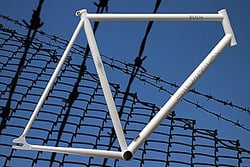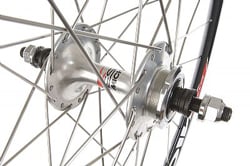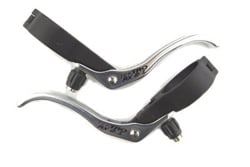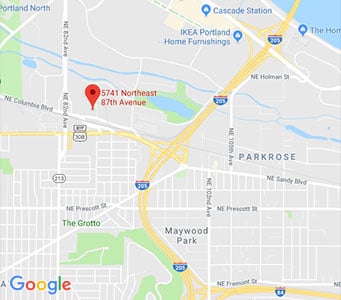Building a Fixed Gear/Single Speed
The fixed gear/single speed trend is the most visible trend to take off in the bike world over the past decade. Fixed gears are usually altered track bikes and are traditionally used by bike messengers, but now also used as stunt bikes or even commuters. Single speeds are bikes in their most minimal form, with one gear, a freewheel, and some brakes. Pretty much any type of frame can be built up as a single speed.
Fixed gear bikes do not allow the rider to coast, at all. The rear gear is "fixed" to the hub. When the pedal turns, the wheel turns—and vice versa. This allows for a variety of tricks, as well as unique ride feel. Ask any fixed gear rider: "it feels like your body is one with the bike!" Fixed gear rides are also popular with racers in the off season; putting in miles on a fixed gear is good for muscle memory (but hard on the knees).
Single speeds are a bit more practical than a standard fixed gear. Single speed bikes are generally cheaper than standard road bikes, as they lack spendy drivetrain components, and easier to maintain. Single speeds are great for commuting and recreational riders.
The Frame
 A track frame is the preferred choice when building a fixed gear bike. Track frames feature horizontal rear dropouts that allow for a wide range of chain tension adjustment. By contrast, new road frames rely on the rear derailleur to tension the chain. When a derailleur is not used, the rear wheel must be positioned to provide adequate chain tension, which is difficult with a road bike's vertical dropouts. Road frames with vertical dropouts can be built up as fixed gear/single speeds, but finding correct chain tension will be a bit more difficult. Older road frames, though, are often equipped with forward facing horizontal dropouts, which also provide a great deal of chain tension adjustment, are are great choices for single speed builds.
A track frame is the preferred choice when building a fixed gear bike. Track frames feature horizontal rear dropouts that allow for a wide range of chain tension adjustment. By contrast, new road frames rely on the rear derailleur to tension the chain. When a derailleur is not used, the rear wheel must be positioned to provide adequate chain tension, which is difficult with a road bike's vertical dropouts. Road frames with vertical dropouts can be built up as fixed gear/single speeds, but finding correct chain tension will be a bit more difficult. Older road frames, though, are often equipped with forward facing horizontal dropouts, which also provide a great deal of chain tension adjustment, are are great choices for single speed builds.
Track frames are also designed for very quick handling. Forks usually have ~35mm of rake, bottom brackets are positioned higher, and wheelbases tend to be relatively short.
Pedals
Single speed and urban fixed gear riders generally use platform pedals, sometimes with toe clips. Toe clips require toe straps, which are a cyclist's version of duct tape. They can be used for much more than just securing your feet.
Track racers tend to use standard road pedals, with the tension set as high as it will go.
The Wheels
Fixed gear bikes rely on purpose-built wheelsets with a gear "fixed" to the hub. Fixed gear wheelsets usually utilize 120mm wide hubs and are built without dish: the front and rear wheels are both built symmetrically around the hubs. Track wheels utilize a track cog on the rear wheel which simply threads on to the hub and is secured by a lockring.
 With the rise in the popularity of fixed gear bikes, we see more and more standard road hubs that have been altered to accommodate a fixed gear. This is by no means safe, and can lead to catastrophic failure. Road wheels are not built to handle tension pushing both ways, as a track wheel requires, nor will they provide a proper chain line.
With the rise in the popularity of fixed gear bikes, we see more and more standard road hubs that have been altered to accommodate a fixed gear. This is by no means safe, and can lead to catastrophic failure. Road wheels are not built to handle tension pushing both ways, as a track wheel requires, nor will they provide a proper chain line.
Wheels for a single speed are an easier proposition. Track wheelsets with a freewheel (or a flip-flop hub) are ideal for single speeds, but regular road wheels with a single rear cog are perfectly adequate. Spacers can be used on the freehub of a road wheelset to provide an adequate chain line.
'Bars/Stem
Components for either fixed gear or single speed bikes are the fun part, because there aren't very many you have to worry about. Standard handlebars and stems can be used with either, and since you don't have to worry about accommodating shift levers, you've got lots of options. Track-specific handlebars have deep drops for the real sprinters. They are not designed to accommodate brake levers.
Cranksets
Standard road cranksets are easily converted for use with single and fixed gear bikes. Standard double cranks will have no problem running a single chainring. A 42 tooth is a good size for most terrain. There are also track-specific cranksets available. Track cranks utilize a 1/8 in. drive and have much bigger gears that are best suited for velodrome use. When shopping for chainrings, remember to consider your crank's BCD (bolt circle diameter). Road cranks typically have a BCD of 130mm (or 110 if you're using a compact); track cranks have a 144mm BCD.
When shopping for track components, it's important to note that, unlike road parts, track components are built with only strength and stiffness in mind. Velodromes do not go uphill, so saving weight anywhere but the wheelset is generally not a big issue in track racing.
Brakes
 Purist fixed gear riders often prefer to ride without brakes. Brakeless riding is an enjoyable skill that requires riders learn to see the road, preserve momentum and choose good lines. It is also EXTREMELY DANGEROUS, and not particularly practical for day-to-day riding. While many riders feel perfectly comfortable cruising along sans-brakes, they are woefully unprepared for the car up ahead that unexpectedly blows a stop sign, or that person who opens her door into the bike-lane without looking over her shoulder.
Purist fixed gear riders often prefer to ride without brakes. Brakeless riding is an enjoyable skill that requires riders learn to see the road, preserve momentum and choose good lines. It is also EXTREMELY DANGEROUS, and not particularly practical for day-to-day riding. While many riders feel perfectly comfortable cruising along sans-brakes, they are woefully unprepared for the car up ahead that unexpectedly blows a stop sign, or that person who opens her door into the bike-lane without looking over her shoulder.
Therefore, if a fixed gear bike is your chosen means of two-wheeled transport, a front brake is essential. Look for a caliper brake with plenty of stopping power that will accommodate your frame and fork set-up. Running a brake doesn't mean you have to sacrifice the clean lines of your fixie; brake levers are available that will provide stopping power and a subtle appearance. Single speeds handle best with brakes on the front and rear.
Whether your riding style includes match sprints or sick wheelies, our staff at WesternBikeworks.com is experienced on city streets and the velodrome. Feel free to contact us at [email protected] or 1-800-651-4050 with any questions about building up your dream urban ride, single or fixed.





